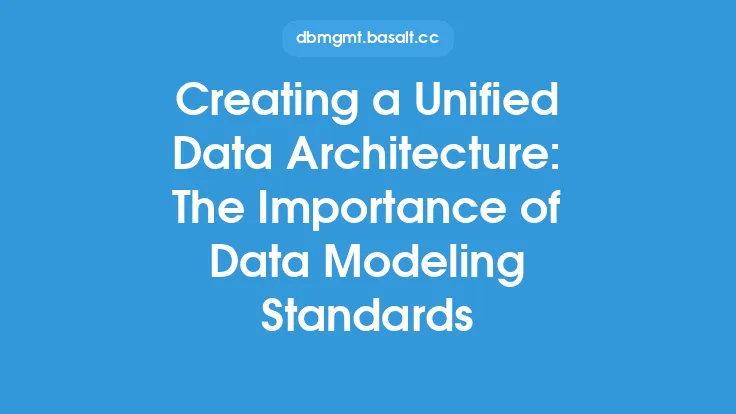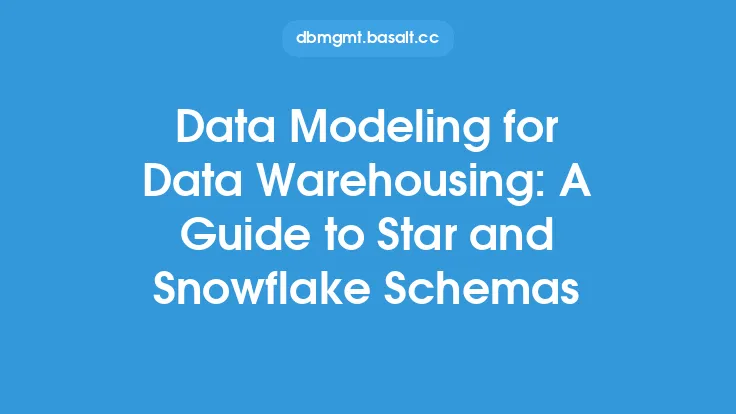Data warehousing is a crucial aspect of business intelligence, enabling organizations to make informed decisions by providing a centralized repository of data. At the heart of a data warehouse is its architecture, which is designed to support the complex process of data integration, storage, and analysis. A well-designed data warehouse architecture is essential for ensuring that an organization's data is properly organized, easily accessible, and scalable for future growth. In this article, we will delve into the world of data warehouse architecture, exploring the key components, data modeling approaches, and best practices for designing a robust and efficient data warehouse.
Introduction to Data Warehouse Architecture
A data warehouse architecture typically consists of several layers, each with its own specific function. The most common layers include the source systems layer, data integration layer, data storage layer, and data access layer. The source systems layer consists of the various data sources that feed into the data warehouse, such as transactional databases, log files, and external data sources. The data integration layer is responsible for extracting, transforming, and loading (ETL) data from the source systems into the data warehouse. The data storage layer is where the data is actually stored, and the data access layer provides a interface for users to access and analyze the data.
Data Modeling Approaches
Data modeling is a critical aspect of data warehouse architecture, as it provides a conceptual representation of the data and its relationships. There are several data modeling approaches that can be used in data warehousing, including entity-relationship modeling, dimensional modeling, and object-oriented modeling. Entity-relationship modeling is a traditional approach that focuses on the entities and relationships within the data. Dimensional modeling, on the other hand, is a more specialized approach that is specifically designed for data warehousing. It involves organizing data into facts and dimensions, where facts are the measurable events and dimensions are the contexts in which the events occur. Object-oriented modeling is a more modern approach that uses objects and classes to represent the data and its relationships.
Dimensional Modeling
Dimensional modeling is a popular data modeling approach in data warehousing, as it provides a simple and intuitive way to organize and analyze data. In dimensional modeling, data is organized into facts and dimensions, where facts are the measurable events and dimensions are the contexts in which the events occur. For example, in a sales data warehouse, the facts might include sales amount, quantity, and date, while the dimensions might include customer, product, and region. Dimensional modeling involves creating a star or snowflake schema, where the fact table is at the center and the dimension tables are connected to it. The star schema is a simpler approach, where each dimension is represented by a single table, while the snowflake schema is a more complex approach, where each dimension is represented by multiple tables.
Data Warehouse Schema
A data warehouse schema is a visual representation of the data warehouse architecture, showing the relationships between the different tables and layers. There are several types of data warehouse schemas, including star, snowflake, and galaxy schemas. A star schema is a simple schema that consists of a fact table surrounded by dimension tables. A snowflake schema is a more complex schema that consists of a fact table surrounded by dimension tables, which are further divided into sub-dimension tables. A galaxy schema is a schema that consists of multiple fact tables, each with its own set of dimension tables. The choice of schema depends on the specific requirements of the data warehouse and the complexity of the data.
Data Mart Architecture
A data mart is a subset of the data warehouse, designed to support a specific business function or department. Data mart architecture is similar to data warehouse architecture, but it is typically smaller and more focused. A data mart typically consists of a single schema, such as a star or snowflake schema, and is designed to support a specific set of queries and analysis. Data marts are often used to provide a more targeted and efficient way to analyze data, and can be used to support specific business functions such as sales, marketing, or finance.
Best Practices for Data Warehouse Architecture
Designing a data warehouse architecture requires careful planning and consideration of several factors, including data volume, data complexity, and user requirements. Some best practices for data warehouse architecture include using a scalable and flexible architecture, designing a robust and efficient ETL process, and using data modeling techniques to organize and structure the data. It is also important to consider data governance and security, and to ensure that the data warehouse is properly documented and maintained. Additionally, it is essential to test and validate the data warehouse architecture to ensure that it meets the requirements of the organization and is able to support the complex process of data integration, storage, and analysis.
Conclusion
In conclusion, data warehouse architecture is a critical aspect of business intelligence, enabling organizations to make informed decisions by providing a centralized repository of data. A well-designed data warehouse architecture is essential for ensuring that an organization's data is properly organized, easily accessible, and scalable for future growth. By using data modeling approaches such as dimensional modeling, and following best practices for data warehouse architecture, organizations can create a robust and efficient data warehouse that supports their business intelligence needs. Whether you are designing a new data warehouse or optimizing an existing one, understanding the key components and data modeling approaches of data warehouse architecture is essential for ensuring the success of your business intelligence initiatives.





